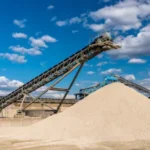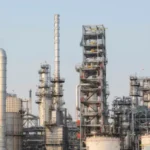Choosing the Right Cement Accelerator: A Detailed Guide

Cementing plays a vital role in well construction, directly impacting long term wellbore integrity and zonal isolation. Accelerating admixtures are specialized chemical additives that decrease the setting and hardening time of cement, making them essential for rapid construction and repair applications. They reduce cement setting time and boost early strength, critical for fast paced drilling and completion operations.
This guide breaks down the types of cement accelerators, how they work and where they fit best. From chloride based to non chloride options, understanding their mechanisms and application practices helps drilling engineers, procurement teams and wellsite professionals make informed choices aligned with performance, safety and regulatory goals.
What is a Cement Accelerator?
Cement accelerators are chemical cementing additives (a type of admixture) used to speed up the hydration process of cement, cutting down the time it takes to set and gain early strength. In oilfield operations, this is crucial as faster setting means less downtime and better control over well integrity.
Accelerators in cement are commonly used in both primary cementing where casing is sealed to the formation and remedial cementing jobs that fix or reinforce existing well structures. Whether you’re working in cold climates, offshore rigs or shallow gas prone zones, choosing the right accelerator helps reduce operational delays and improve early compressive strength when it counts.
Common Uses in Oilfield Operations
- Reducing wait on cement (WOC) time – Speeds up setting, allowing rigs to resume operations faster
- Enhancing early compressive strength – Helps the cement resist formation pressures sooner
- Preventing gas migration – Especially useful in shallow wells where early strength is critical
- Use in cold/offshore environments – Maintains performance even when temperatures slow natural hydration
Accelerators are applied across both primary and remedial cementing workflows, making them a versatile tool for drilling engineers and wellsite teams.
Types of Cement Accelerators
Accelerators are a type of admixture, a broader category of chemical additives used to modify the properties of cement slurries. Each additive has unique properties that influence the performance and setting characteristics of the cement.
Accelerators vary in chemical makeup and performance. Choosing the right one depends on well conditions, slurry design and operational goals. Below are the most common types used in oilfield cementing.
1. Calcium Chloride (CaCl₂)
The most popular accelerator in oilfield cementing, calcium chloride, speeds up the hydration of tricalcium silicate (C₃S), leading to faster setting and early strength gain. Its typical dosage is 2 to 4 percent by weight of cement. It is cost effective, provides fast strength development and is ideal for cold conditions. However, it can cause corrosion in steel casing and reduce long term durability if overdosed.
2. Sodium Chloride (NaCl)
Sodium chloride is used less frequently. It is utilized mainly in high density slurries or where cost and availability drive selection. Readily available, it can accelerate at low concentrations (up to 15% by weight of the mix water). However, its efficiency drops at higher concentrations and may retard setting above 20 percent.
3. Gypsum (Calcium Sulfate)
Gypsum is often used as an additive in combination with other chemicals to regulate setting and improve compatibility. It also finds application in specialty mortar blends, where it helps control setting time and enhances compatibility with other components. Additionally, gypsum is used in specialty blends, shotcrete and offshore cementing, and is important for controlling ettringite formation and supporting early strength in sulfate-rich environments.
4. Aluminum Sulfate and Other Inorganic Salts
These are used in alkali free formulations or where chloride free performance is required. They promote ettringite formation and are effective in cold and underground settings. These can inhibit calcium silicate hydration at high dosages.
5. Commercial Blends
These are custom formulations combining CaCl₂, aluminum salts and other accelerants to match specific well conditions with use cases such as tailored setting times, improved compatibility with other additives and reduced corrosion risk.
Sunita Hydrocolloids offers advanced cement accelerator blends designed for oilfield applications. These commercial blends are formulated for compatibility with various cementing systems, ensuring effective performance alongside other cement admixtures.
How Cement Accelerators Work
Cement accelerators work by promoting the acceleration of the hydration of tricalcium silicate (C₃S), the key compound responsible for early strength in cement. The addition of accelerators to the cement mix influences the rate of hydration and early strength development. The chemical reaction is triggered by a rise in ionic concentration in the mixed water, which alters the behavior of the aqueous phase and promotes faster formation of calcium silicate hydrate (C-S-H).
Mechanism Breakdown
- Ionic concentration increases – Accelerators release ions (Ca²⁺, Cl⁻, Na⁺) into the mixed water, boosting reactivity in the slurry.
- Faster nucleation of C-S-H – These ions promote early formation of calcium silicate hydrate, the backbone of cement strength.
- Accelerated hardening – The slurry transitions from plastic to solid faster, reducing wait on cement time and improving early compressive strength.
Performance Factors to Watch
- Cement class: Class G and H respond differently to accelerators
- Temperature and pressure: Higher temperatures speed up hydration; cold environments benefit most from accelerators
- Water content: Impacts ion mobility and reaction rate
- Interaction with other additives: Retarders, extenders and dispersants can affect accelerator efficiency
When to Use Cement Accelerators
Whether you need to use a cement accelerator or not depends on well conditions, slurry design and operational priorities. Using accelerators can provide earlier access to wells by reducing wait times before proceeding with further operations. While they offer clear benefits in time sensitive or low temperature settings, they’re not a one size fits all solution.
Ideal Scenarios
- Low temperatures (<100°F / 38°C) – Accelerators help offset slow hydration and prevent frost related delays
- Shallow wells with gas migration risk – Early strength development helps seal off gas prone zones quickly.
- Fast paced schedules – Offshore rigs, winter drilling and tight turnaround jobs benefit from reduced wait on cement time.
Situations to Avoid or Use Caution
- High temperature environments – Risk of flash setting increases so monitor closely
- Heavy retarder loads – Can interfere with accelerator performance and delay setting
- Salty or reactive formations – Always run compatibility tests to avoid unexpected reactions or loss of strength
Cement Accelerator Market Trends
The cement accelerator market is expanding steadily, driven by the need for faster well construction, improved cementing performance, and the growing demand for cement accelerators in high-performance construction projects. The global market was valued at USD 1.2 billion in 2024 and is forecasted to reach USD 2.5 billion by 2033, growing at a compound annual growth rate of 8.9%. Unconventional drilling in the US has surged, requiring faster set times and stronger early compressive strength.
Offshore and arctic projects are enforcing stricter cementing standards, which accelerators help meet. Operators are also under pressure to reduce wait on cement (WOC) time, making accelerators a practical choice for speeding up rig schedules without compromising integrity.
Regional Focus
Demand for cement accelerators is strongest in high-activity basins like the Permian, Eagle Ford, and Bakken. The Permian Basin leads with aggressive horizontal drilling programs that benefit from rapid cement setting. Eagle Ford’s tight completion schedules make early strength gain critical. In the Bakken, cold climate conditions require accelerators that perform reliably in low temperatures, making them essential for maintaining wellbore integrity during winter operations.
Industry Challenges
Despite growth, the industry faces challenges. Chloride based accelerators are under environmental scrutiny due to their impact on groundwater and long term cement stability. Compatibility issues are also emerging with newer low carbon and green cement formulations which may not react predictably with traditional accelerators. Operators are now looking for products that strike a balance between fast early strength and long term durability, especially in high pressure, high temperature wells.
Key Considerations for Choosing the Right Accelerator
Successful selection balances speed, performance, compatibility and compliance. The right accelerator isn’t just about fast setting; it’s about matching the chemistry to the job so consider these!
A. Formation Temperature
Temperature plays a major role in how accelerators behave. Calcium chloride is highly effective in cold conditions but at elevated temperatures, it can trigger flash setting and compromise pumpability. For high-temperature formations, chloride free options like sodium silicate or aluminum sulfate are safer choices.
B. Cement Type Compatibility
Not all accelerators pair well with specialty cements. Pozzolanic blends, sulfate resistant cements and low carbon formulations may react unpredictably with traditional additives. Always verify compatibility through lab testing before field application.
C. Early Strength Requirements
Projects requiring early load bearing like precast elements or high traffic zones often demand higher accelerator dosages. Calcium formate and silica based accelerators are preferred for boosting early compressive strength without sacrificing long term durability.
D. Slurry Density and Rheology
Accelerators can alter slurry viscosity and flow behavior. This affects pumpability, placement and set time. Lab tests are essential to ensure the mix remains workable and meets operational specs.
E. Environmental Compliance
In sensitive zones, chloride based accelerators may face restrictions. Low chloride or chloride free formulations are preferred, especially near groundwater or protected ecosystems. Always check local regulations before deployment.
Final Thoughts
Choosing the right cement accelerator directly impacts project cost, worker safety and construction timelines. With rising demand for performance driven additives, it’s no longer just about speed, it’s about reliability under pressure. Always match your accelerator to the well conditions and regulatory standards to avoid setbacks.
If you’re looking for proven, high efficiency options, check out cement accelerator solutions from Sunita Hydrocolloids, designed for demanding oilfield applications.





